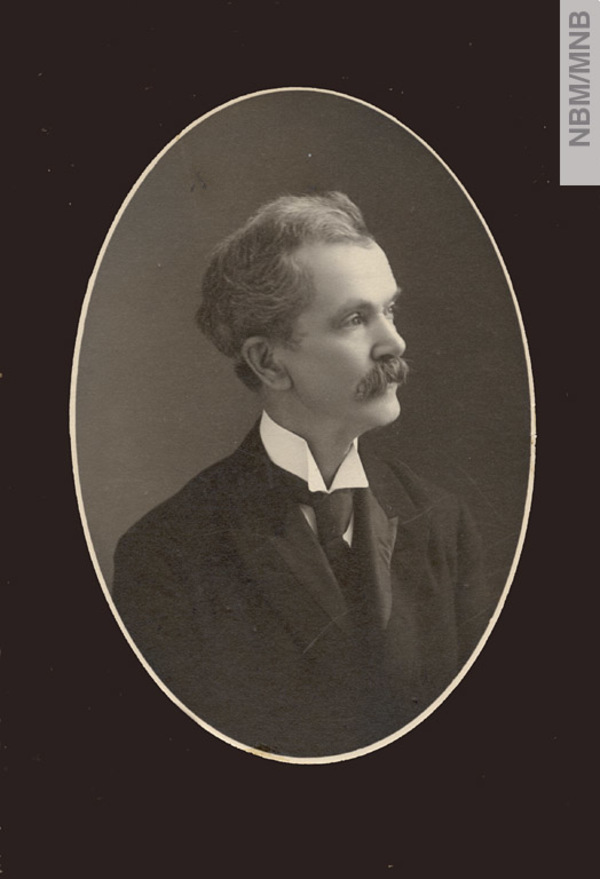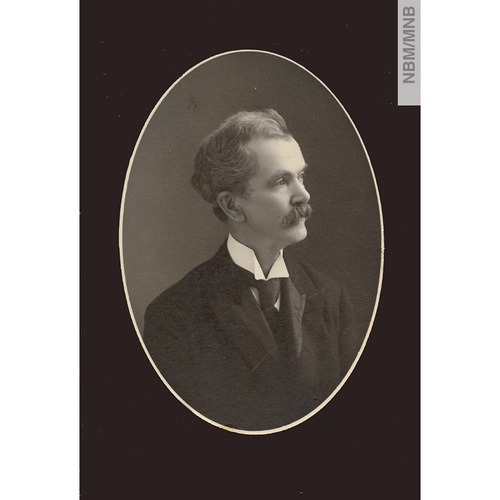
Source: Link
HAY, GEORGE UPHAM, educator, botanist, author, editor, and publisher; b. 18 June 1843 in Norton Parish, N.B., youngest child of William Hay and Eliza Fahy; m. 20 Dec. 1876 Frances Annetta Hartt, sister of Charles Frederick Hartt*, in Saint John; they had no children; d. there 23 April 1913.
George Hay’s father came to Saint John from Digby, N.S., in 1817 and set up first as a shoemaker and later as a farmer in Norton Parish. George attended local schools and then was apprenticed in the printing trade in St Stephen (St Stephen-Milltown). He apparently worked on the St. Croix Herald, a weekly founded by his brother John Smith Hay. During the American Civil War the Herald’s pro-North stance led to harassment culminating on 19 Dec. 1861 in the looting of its press by a mob. How directly these events affected George is not known, but his enrolment in January in the Normal School at Saint John may speak for itself. He earned a second-class teaching licence in April and a first-class licence on re-examination in 1867.
Hay began teaching in November 1862 in his native parish; he was master of the Norton Superior School by 1868. Later an acknowledged authority on the flora of the province, he was in his own words “past the quarter century mark before he was made acquainted with the simplest notions of plants.” His interest may have been kindled by James Fowler*’s “Plea for the study of natural history,” published in 1870 in Stewart’s Quarterly (Saint John). In 1870–71 Hay attended an extramural course in “languages and botany” at Cornell University in Ithaca, N.Y. He returned to teaching for a few terms and then worked for the Saint John Daily News as a reporter and, eventually, night editor. Finding that his health suffered and that he had little time for botanical pursuits, in 1876 he resumed teaching.
When the Natural History Society of New Brunswick (NHSNB) was relaunched in 1880, following several years of inactivity, Hay emerged as a leading member. He founded a herbarium in the society’s museum in 1881 with the donation of his personal collection, begun systematically in 1876, and for the next 33 years he chaired its committee on botany. In this capacity he compiled annual additions to the catalogues of New Brunswick plants published by Fowler in 1879 and 1885, collaborating with several others inspired by Fowler. He also authored narratives of lengthy botanizing excursions by canoe with William Francis Ganong* and others along some of the province’s major waterways. For more limited periods Hay’s collecting encompassed marine algae and fungi, of which he also produced provincial catalogues; these were based in large part on specimen identifications provided by American specialists with whom he corresponded. In an 1893 paper in the Transactions of the Royal Society of Canada, Hay noted with characteristic modesty that he and others engaged in drawing up a botanical inventory in New Brunswick were “only amateurs, and have taken but a few preliminary steps in laying a foundation for . . . higher things,” notably “the investigation of the life-history and other biological relations of plants.” From 1899 he contributed annual notes to the Bulletin of the NHSNB on the amenability to cultivation and the seasonal changes of native plants established in a two-acre “wild garden” on his summer property at Ingleside.
The organization, promotion, and educational work of the NHSNB owed much to Hay. President of the society from 1896 to 1899, he was for most of the period 1880–1913 co-vice-president, program organizer, press agent, and a member of the publications committee, as well as a frequent delegate to the meetings of the RSC. He and a few others were keenly conscious of the limited opportunities for scientific education in Saint John in the absence of a university. The society’s response included the initiation of summer camps for field research and instruction (1883), a provincial summer school of science for teachers (1887), lecture series on elementary natural science (1887), and university extension courses (1891), in all of which Hay assumed responsibility for botany.
Hay was appointed English and science master at the Saint John Grammar School in 1881 and principal of the Victoria School, with its prestigious Girls’ High School, in 1888. He maintained and strengthened Victoria’s reputation, succeeding not as a taskmaster but through his reputedly infectious enthusiasm for learning. A founding member of the Dominion Educational Association in 1892, he sat on its board of directors for several years. In 1892 and 1899 he presided over the Summer School of Science for the Atlantic Provinces of Canada, an outgrowth of the schools established in New Brunswick by the NHSNB and in Nova Scotia by Alexander Howard MacKay*. Despite the high esteem in which he was held, he was passed over for the position of principal when the Victoria and grammar schools were amalgamated in 1897, and he resigned “to the great regret” of the school board.
In 1886 Hay had been made editor of the new bi-weekly New Brunswick Journal of Education (Saint John), which was transformed the next year into the monthly Educational Review for the Maritime provinces. Hay assumed financial responsibility and editorial control, with associate editors for Nova Scotia and Prince Edward Island, and after 1897 devoted his full attention to educational writing. While reflecting the full range of educational issues of the time, the Review concentrated on providing teachers with practical material and suggestions, especially for nature study. Having been persuaded of the need for Canadian history texts that would be more “stimulating . . . to the youthful imagination,” Hay solicited a series of articles by well-known writers which were published as supplements to the Review between 1898 and 1900 and then issued in collective form as Canadian history readings . . . (Saint John, 1900). His own educational writings include A public school history of Canada (Saint John and Toronto, 1901) and A history of New Brunswick; for use in public schools (Toronto, [1903]). A school text on botany, which he and Ganong had projected in 1894, was never written, however, and a manuscript on the flora of the Maritimes, completed with three co-authors in 1911, was for unknown reasons never published.
Hay, who had obtained a b.phil. by correspondence from Illinois Wesleyan University in 1886, was awarded an honorary ma and d.sc. from Acadia University in Wolfville, N.S. Elected to the RSC in 1894, he was president of its section iv in 1903–4. He was also president of the Botanical Club of Canada for 1904–6 and remained active in the NHSNB until his last days, his pivotal role becoming all too evident after his sudden death from a heart attack. Several decades would follow in which the only botanists afield in New Brunswick came from outside its borders. Moreover, although the society’s membership remained high, its Bulletin folded for want of the practical and scientific underpinning which Hay and a few others had provided. Hay’s botanical collections and publications none the less remain an important part of the documentation of New Brunswick’s flora. They provide a gauge of the impact of 20th-century land use on the province’s natural ecosystems.
Hay’s record was one of solid achievement as a botanist, educator, and journalist. Referring to his varied career and exceptional personal qualities, three of New Brunswick’s prominent citizens – William Odber Raymond*, William S. Carter, and James Vroom – wrote in the Educational Review (which continued with Mrs Hay as publisher), “There are few of New Brunswick’s many distinguished sons whose life touched and influenced so many other lives – and always for good.”
George Upham Hay was a prolific author. A partial list of his publications, compiled by the contributor, is available in the DCB’s files. Most of his scientific writings are listed as well in Science and technology biblio. (Richardson and MacDonald).
A four-page (900-word) handwritten autobiography by Hay, dated February 1905, is preserved in the N.B. Museum, W. F. Ganong papers, “New Brunswick biography” scrapbook, item 47.
N.B. Museum, W. F. Ganong papers, W. F. Ganong, “The history of botanical investigation in New Brunswick,” ch.4, sect.1 of his unpublished study, “The province of New Brunswick,” vol.1 (“Physical geography and natural history,” [1919?]); Natural Hist. Soc. of New Brunswick, records, G. U. Hay mss. Saint John Globe, 24 April 1913. Carl Berger, Science, God, and nature in Victorian Canada (Toronto, 1983). A history of the Saint John Grammar School, 1805–1914 (Saint John, 1914). W. O. Raymond et al., “George Upham Hay,” Educational Rev. (Saint John), [26] (1912–13): 255. RSC, Trans., 3rd ser., 7 (1913), proc.: xix–xxi. C. M. Young, “History of plant collections,” in H. R. Hinds, Flora of New Brunswick . . . (Fredericton, 1986), v–ix.
Cite This Article
Stephen R. Clayden, “HAY, GEORGE UPHAM,” in Dictionary of Canadian Biography, vol. 14, University of Toronto/Université Laval, 2003–, accessed April 24, 2025, https://www.biographi.ca/en/bio/hay_george_upham_14E.html.
The citation above shows the format for footnotes and endnotes according to the Chicago manual of style (16th edition). Information to be used in other citation formats:
| Permalink: | https://www.biographi.ca/en/bio/hay_george_upham_14E.html |
| Author of Article: | Stephen R. Clayden |
| Title of Article: | HAY, GEORGE UPHAM |
| Publication Name: | Dictionary of Canadian Biography, vol. 14 |
| Publisher: | University of Toronto/Université Laval |
| Year of revision: | 1998 |
| Access Date: | April 24, 2025 |



